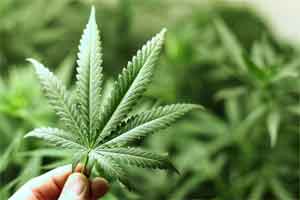Marijuana use may be linked to temporarily weakened heart muscle

Younger marijuana users were twice as likely as non-users to experience stress cardiomyopathy, a sudden, usually temporary, weakening of the heart muscle that occurs more commonly in older women. If you use marijuana and experience chest pain or shortness of breath, seek medical help to rule out this infrequent but serious condition.
 Active marijuana use may double the risk of stress cardiomyopathy, an uncommon heart muscle malfunction that can mimic heart attack symptoms, according to research presented at the American Heart Association’s Scientific Sessions 2016.
Active marijuana use may double the risk of stress cardiomyopathy, an uncommon heart muscle malfunction that can mimic heart attack symptoms, according to research presented at the American Heart Association’s Scientific Sessions 2016.
The researchers found that marijuana users were almost twice as likely to develop stress cardiomyopathy compared to non-users, even after taking other cardiovascular risk factors into consideration. Active marijuana use was identified either by information provided by the patient in their medical history, or by a marker in the patient’s urine.
“The effects of marijuana, especially on the cardiovascular system, are not well known yet. With its increasing availability and legalization in some states, people need to know that marijuana may be harmful to the heart and blood vessels in some people,” said Amitoj Singh, M.D. study co-author and chief cardiology fellow at St. Luke’s University Health Network in Bethlehem, Pennsylvania.
Stress cardiomyopathy is a sudden, usually temporary, weakening of the heart muscle that reduces the heart’s ability to pump, leading to chest pain, shortness of breath, dizziness and sometimes fainting.
Data from the Nationwide Inpatient Sample identified 33,343 people who were hospitalized with stress cardiomyopathy between 2003-2011 in the United States. Of those, 210 (less than one percent) were also identified as marijuana users.
Compared with non-users, researchers found that marijuana users were more likely to be younger, male with fewer cardiovascular risk factors, including less high blood pressure, diabetes and high cholesterol.
However, despite being younger and with fewer cardiovascular risk factors than non-users, during stress cardiomyopathy the marijuana users were significantly more likely to go into cardiac arrest (2.4 percent vs. 0.8 percent) and to require an implanted defibrillator to detect and correct dangerously abnormal heart rhythms (2.4 percent vs. 0.6 percent).
“This development of stress cardiomyopathy in younger patients who used marijuana suggests a possible link that needs to be further investigated,” said Sahil Agrawal, M.D., co-author of the paper and also a chief cardiology fellow at St. Luke’s.
Marijuana users were more likely than non-users to have a history of depression (32.9 percent vs. 14.5 percent), psychosis (11.9 percent vs. 3.8 percent), anxiety disorder (28.4 percent vs. 16.2 percent), alcoholism (13.3 percent vs. 2.8 percent), tobacco use (73.3 percent vs. 28.6 percent) and multiple substance abuse (11.4 percent vs. 0.3 percent). Because some of these can increase the risk of stress cardiomyopathy, the researchers adjusted for known risk factors to investigate the association between marijuana use and stress cardiomyopathy.
“If you are using marijuana and develop symptoms such as chest pain and shortness of breath, you should be evaluated by a healthcare provider to make sure you aren’t having stress cardiomyopathy or another heart problem,” Singh said.
The study has some limitations. Because this was a retrospective study, the researchers could not determine how frequently the marijuana users were using marijuana, or what the timeframe was between the use of marijuana and occurrence of stress cardiomyopathy. Observational studies are not designed to prove cause and effect; therefore, it cannot be said that marijuana is or is not a direct cause of stress cardiomyopathy. In addition, because the database the researchers used reports regional but not state-by-state statistics, the researchers could not analyze whether possibly marijuana-related heart problems are increasing where use is legal.
Source: American Heart Association
Full bibliographic information:
Marijuana (Cannabis) Use is an Independent Predictor of Stress Cardiomyopathy in Younger Men

